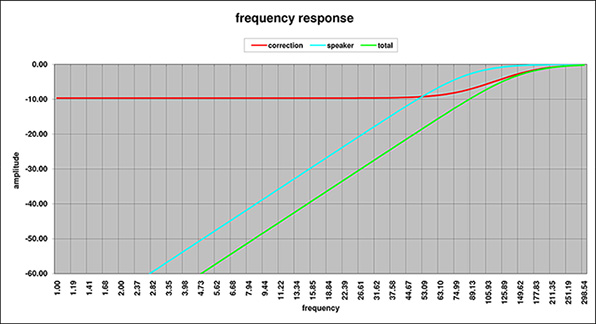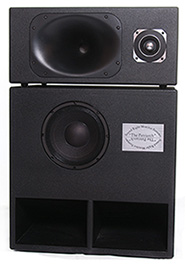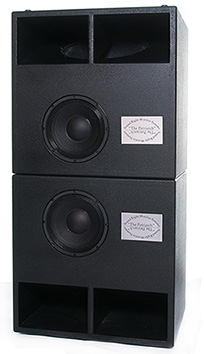Reviews
Read what some of the leading reviewers said about some of
David’s designs!
the amount of low bass energy
this speaker can produce is astounding..
is up there with the
established big boys, ATC, Genelec, PMC and the rest..
Hugh Robjohns
..an optional, I would
suggest imperative extra is on site analysis and alignment of the
system..
the
results were most impressive, exhibiting delicacy and presence
conveying the subtle detail..that few boxed loudspeakers can equal
Ivor Humphreys
"there
was absolutely no hint of either compression or distortion, just
limitless power coupled with lightning speed"
David Allcock
Other Links
Peter Mapp article
and others, Look here.

|
The Patriarch System is a modular loudspeaker system with the emphasis on accurate sound reproduction and high efficiency.
In it’s simpler form (pic1) the Patriarch system is a highly capable studio monitor at a competitive price.
A long excursion 15” bass driver provides a deep tight bass with the power handling and low group delay associated with sealed cabinets.
The 10” midrange works into a sealed chamber shaped to minimise standing waves and the 3” coil titanium diaphragm compression driver coupled to an elliptical tractrix horn produces a flat response, controlled dispersion and low distortion which is a feature of the horn profile which allows the sound wave to expand at a natural rate.
The ring radiator tweeter is also fitted with a titanium diaphragm. The massive magnet assembly enables this device to match the tractrix horn in efficiency and dispersion. This unit has an extended response to 22Khz.
The Patriarch plays music with accuracy and real world dynamics. Their efficiency and detailed reproduction ensure they are compatible with your monitoring needs and their low distortion and musicality make them equally at home for high end domestic systems. |
Suggested crossover frequencies for the Studio Monitor configuration are 250Hz/900Hz/8000Hz with Linkwitz Riley 24dB/octave slopes recommended. Further gains in performance may be achieved time aligning the drivers by matching the cone drivers and tweeter acoustic centres to the acoustic centre of the elliptical tractrix horn driver. For this DSP loudspeaker management would be mandatory.
Stacking the Patriarch system bass/mid cabinets as shown (pic 2) brings gains in power handling and maximum spl (in excess of 125dB/watt/metre within the driver’s linear excursion, providing 130dB + peak within maximum cone excursion limits) but it also provides other benefits.
In this set up the Patriarch System performs as a dipolar array which results in controlled vertical dispersion. The benefit gains are to reduce the destructive interference caused by ceiling and floor reflections making this configuration well suited to many applications which include live band, theatre, cinema, houses of worship and halls.
Excellent vertical dispersion control is achieved up to 450Hz. The addition of a large theatre sized horn working from this frequency, compact high efficiency cabinet speakers or DML panel arrays would all be good matches for this system depending on the specific application.
The driver spacing in the dipolar array creates the tight vertical dispersion but to minimise irregular response patterns, particularly off axis, the crossover points become more critical. Maximum crossover points are 150Hz for bass to midrange and without the eq adjustment described in another section, no greater than a 470Hz low pass for the 10” midrange units. There is a technique to take them around an octave higher which is described in “Read More”!
The driver spacing in the dipolar array creates the vertical dispersion control but to minimise irregular response patterns the crossover points become critical and must be observed! Maximum crossover points are 150Hz for bass to midrange and ideally no greater than a 470Hz low pass for the 10” midrange units.
DSP loudspeaker management is advised to optimise the performance of this stacked arrangement for the following reason. The midrange drivers are mounted into sealed cabinets and have a natural roll off at around 80Hz. This represents less of an issue for the Studio Monitor as the crossover is recommended to be around 250Hz with a 4th order Linkwitz Riley filter, but at 150Hz for the Dipolar Stack the natural 80Hz roll off should be taken into consideration. Eq is applied to create a 150Hz 12dB/octave Butterworth slope instead of the natural (f3) of 80Hz from the cabinet loading alone.
Setting a 12dB/octave active HP Butterworth filter at 150Hz on the active crossover will combine with the midrange cabinet’s new response to create a 24dB/octave Linkwitz Riley filter which is our target .
The eq correction curve is in effect a Linkwitz Transform and this curve is shown below. Final combined response of the whole stack can be measured and corrected as desired.
 |
Shown is the eq curve in Red that needs to be applied to the mid range driver to create a 150Hz 12dB/Octave Butterworth HP slope. The resultant final curve is shown in Green.
When the active 12dB/octave Butterworth filter is applied at 150 Hz, the final response should be 24dB/Octave Linkwitz Riley!
Specifications
Patriarch Bass/Mid Box
Dimensions
Power Handling Midrange: 200watts cont., 400 watts peak Bass sensitivity: 97dB/watt/metre Midrange sensitivity: 93.5dB/watt/metre
Recommended crossover frequencies Bass up to around 350Hz max Midrange up to around 800Hz
Price per cabinet
£875 + VAT (Anti scuff stipple satin black) |
Patriarch Horn and Top Box
Dimensions 635mm (W) x 285mm (H) x 460mm (D)
Power Handling Tractrix Horn: 100watts programme Ring Radiator Tweeter: 50watts cont. Tractrix Horn: 60 x 50 degrees Ring Radiator: 60 x 60 degrees
Recommended crossover frequencies Tractrix Horn: 800Hz & 6k8Hz Ring Radiator: 6k8Hz Sensitivity: 110dB/watt/metre for both
Price per cabinet
£575 + VAT (Anti scuff stipple satin black) |
![]()

